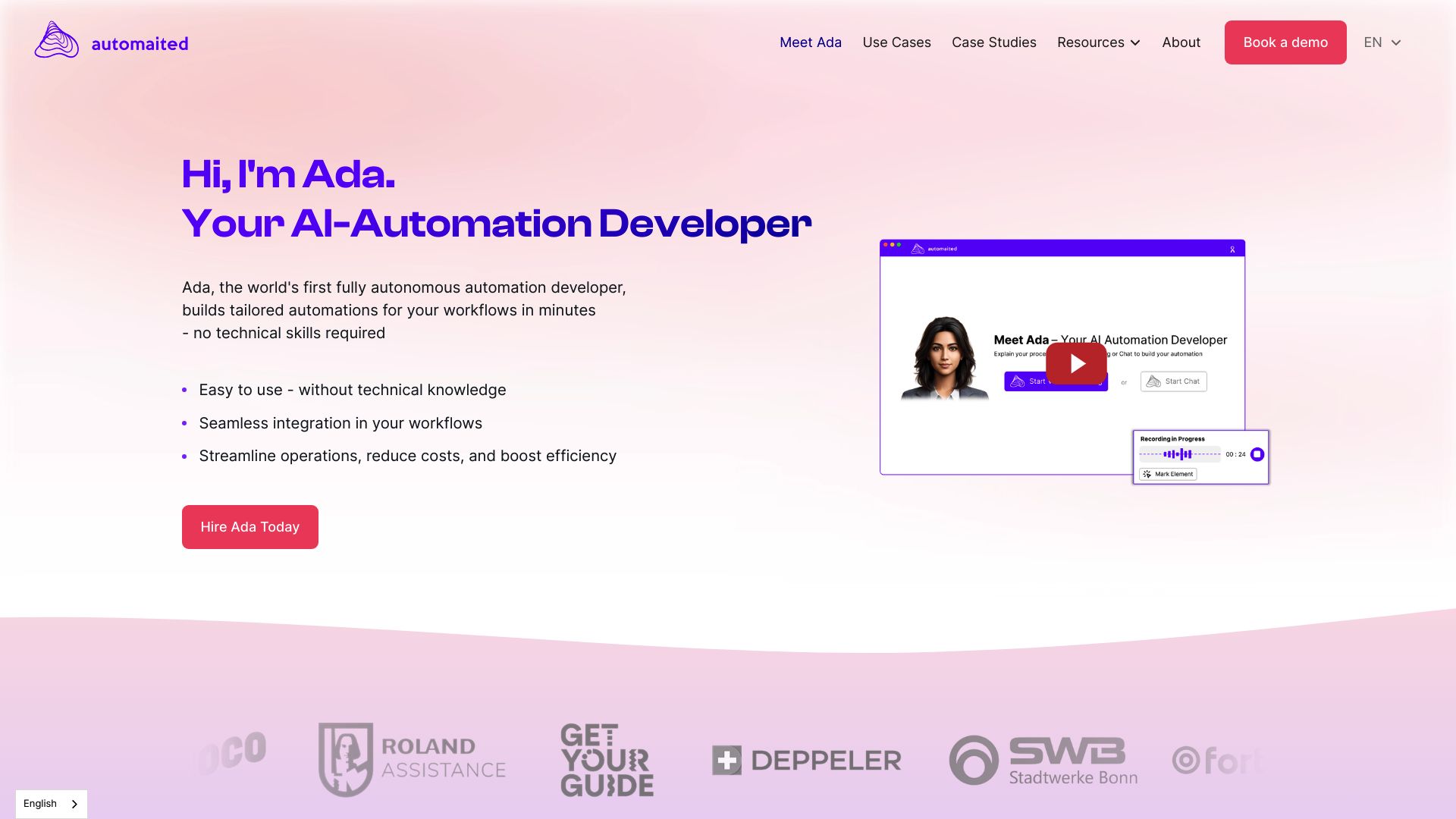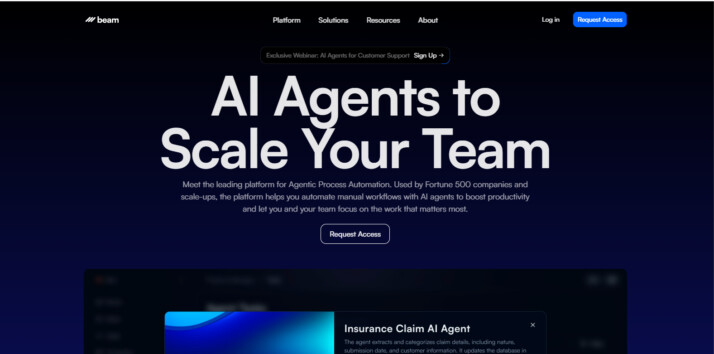Automaited vs. Beam AI: Comparing AI Automation Platforms
AI-powered automation platforms are transforming how businesses operate, promising increased efficiency and productivity. This comparison explores Automaited vs. Beam AI, and SmythOS, three innovative solutions at the forefront of this revolution. We’ll examine their key features, strengths, and limitations to help you determine which platform best suits your organization’s needs. Whether you’re a developer seeking powerful API integrations, a business leader focused on scalability and security, or a non-technical user looking for intuitive tools, this guide will provide valuable insights into how these platforms can streamline your workflows and unlock new possibilities in AI-driven automation.
Automaited Overview
Automaited empowers businesses to streamline operations through AI-driven automation. This platform stands out by enabling users to create and manage complex automations without coding skills, leveraging a chat-based interface for intuitive interaction.


Automaited excels in automating data transfer, text generation, and content summarization across over 1,000 applications. Its AI agents collect system data and user context to refine automations, executing tasks autonomously based on provided instructions. This approach significantly reduces manual workload, allowing teams to focus on high-value activities.
Automaited excels in automating data transfer, text generation, and content summarization across over 1,000 applications.
The platform’s strength lies in its accessibility. Users interact with the AI through a conversational interface, creating smart buttons for easy task execution. This design democratizes automation, making it available to non-technical users while maintaining robust capabilities for complex processes.
Automaited prioritizes compliance and security, adhering to GDPR standards to protect sensitive data. While the platform offers extensive integration options, it lacks some advanced features like multimodal inputs or a visual builder. However, its problem-solving capabilities and ability to handle bulk work compensate for these limitations, making it a powerful tool for businesses seeking to enhance productivity and accuracy in their operations.
Beam AI Overview
Beam AI develops generative AI agents designed to automate repetitive tasks across organizations. Their Agentic Process Automations (APAs) handle data extraction, customer inquiries, compliance tasks, and order processing more efficiently than human workers. These AI agents continuously learn and adapt, improving precision over time.


Beam AI develops generative AI agents designed to automate repetitive tasks across organizations.
The platform focuses on back-office automation, customer service, compliance, and order processing. Beam AI’s solutions integrate with existing systems to plan and execute workflows autonomously. Users interact with the AI through a chat interface to create and manage automations without coding skills.
Beam AI emphasizes sustainability by minimizing steps and reducing human carbon footprints. The company values speed, aiming to save time and boost efficiency. Their international team works towards a future led by artificial general intelligence (AGI). However, Beam AI lacks some advanced features like visual builders, multi-agent collaboration, and extensive deployment options.
Beam AI provides AI-powered automation capabilities but has limitations compared to more comprehensive platforms. While it offers problem-solving abilities and human-AI interaction, it doesn’t support features like hosted vector databases, OAuth authentication, or deployment as APIs. The platform focuses on specific use cases rather than providing a full suite of AI agent development tools.
Feature Comparison
Automaited and Beam AI offer AI-powered automation capabilities, but lack some of the advanced features found in SmythOS. While both platforms enable users to create automations through chat interfaces without coding, they fall short in areas like visual builders, multi-agent collaboration, and extensive deployment options.
SmythOS provides a more comprehensive suite of tools for AI agent development. Its drag-and-drop visual builder allows for intuitive creation of complex workflows, surpassing the chat-based interfaces of Automaited and Beam AI. SmythOS also supports multi-agent systems, enabling collaborative problem-solving between AI agents — a capability absent in both Automaited and Beam AI.
In terms of security, SmythOS offers more robust features. It implements data encryption, OAuth authentication, and IP control, providing a higher level of data protection and access management. Automaited and Beam AI, while emphasizing data security, lack specifics on these advanced security measures. SmythOS also excels in deployment flexibility, offering options to deploy agents as APIs, webhooks, scheduled tasks, and more — versatility not explicitly mentioned for Automaited or Beam AI.
Feature Comparison Table
| Automaited | Beam AI | SmythOS | |
|---|---|---|---|
| CORE FEATURES | |||
| Hosted Agents (Dev, Production) | ❌ | ✅ | ✅ |
| Environments (Dev, Production) | ❌ | ✅ | ✅ |
| Visual Builder | ❌ | ❌ | ✅ |
| No-Code Options | ✅ | ❌ | ✅ |
| Debug Tools | ❌ | ❌ | ✅ |
| Multimodal | ❌ | ❌ | ✅ |
| Multi-Agent Collaboration | ❌ | ✅ | ✅ |
| Audit Logs for Analytics | ❌ | ✅ | ✅ |
| SECURITY | |||
| Constrained Alignment | ❌ | ✅ | ✅ |
| OAuth | ❌ | ✅ | ✅ |
| IP Control | ❌ | ✅ | ✅ |
| COMPONENTS | |||
| Foundation AIs | ❌ | ✅ | ✅ |
| Huggingface AIs | ❌ | ✅ | ✅ |
| Zapier APIs | ❌ | ✅ | ✅ |
| Classifiers | ❌ | ✅ | ✅ |
| Data Lakes | ❌ | ❌ | ✅ |
| DEPLOYMENT OPTIONS (EMBODIMENTS) | |||
| Deploy as API | ❌ | ✅ | ✅ |
| Deploy as Webhook | ❌ | ✅ | ✅ |
| Staging Domains | ❌ | ✅ | ✅ |
| Production Domains | ❌ | ✅ | ✅ |
| API Authentication (OAuth + Key) | ❌ | ✅ | ✅ |
| Deploy as Site Chat | ❌ | ✅ | ✅ |
| Deploy as Scheduled Agent | ❌ | ✅ | ✅ |
| Deploy as GPT | ❌ | ✅ | ✅ |
| DATA LAKE SUPPORT | |||
| Hosted Vector Database | ❌ | ❌ | ✅ |
| Sitemap Crawler | ❌ | ❌ | ✅ |
| YouTube Transcript Crawler | ❌ | ❌ | ✅ |
| URL Crawler | ❌ | ❌ | ✅ |
Best Alternative to Automaited and Beam AI
SmythOS stands out as the superior alternative to Automaited and Beam AI, offering a comprehensive AI automation platform that surpasses its competitors in versatility, ease of use, and feature richness. We designed SmythOS to streamline the creation and deployment of AI agents, making advanced AI functionalities accessible to users of all skill levels.
Our platform’s intuitive drag-and-drop interface sets it apart from Automaited and Beam AI’s chat-based systems. This visual builder allows users to craft complex AI workflows without extensive coding knowledge, democratizing AI development across industries. SmythOS supports multi-agent collaboration, enabling teams of AI agents to work together on sophisticated tasks — a capability not found in Automaited and limited in Beam AI.
SmythOS excels in deployment flexibility, offering options to deploy agents as APIs, webhooks, scheduled tasks, and more.
SmythOS excels in deployment flexibility, offering options to deploy agents as APIs, webhooks, scheduled tasks, and more. This versatility ensures that AI solutions integrate seamlessly into existing systems, addressing a wider range of use cases than Automaited or Beam AI. Our platform also prioritizes security, implementing robust features like data encryption, OAuth authentication, and IP control, providing a higher level of data protection and access management.
With SmythOS, users gain access to a rich ecosystem of pre-built API integrations and support for various AI models from providers like OpenAI, Anthropic, and Hugging Face. This extensive integration capability, combined with our platform’s scalability and performance optimization, makes SmythOS the ideal choice for businesses looking to leverage AI across their operations efficiently and effectively.
By choosing SmythOS, users unlock unlimited possibilities for AI automation, benefiting from a platform that continuously evolves to meet the demands of a rapidly changing technological landscape. Our commitment to innovation and user-centric design ensures that SmythOS remains at the forefront of AI agent development, empowering businesses to achieve unprecedented levels of efficiency and innovation.
Conclusion
Automaited and Beam AI offer valuable automation capabilities, but SmythOS emerges as the superior choice for businesses seeking comprehensive AI agent development and deployment. While Automaited excels in data transfer and text generation across numerous applications, and Beam AI focuses on back-office automation and customer service, SmythOS provides a more robust and versatile platform.
SmythOS stands out with its intuitive drag-and-drop interface, extensive integration ecosystem, and support for multi-agent collaboration. These features enable users to create complex AI workflows without extensive coding knowledge, making advanced AI functionalities accessible to a broader audience. The platform’s ability to deploy agents across various environments, from APIs to chatbots, offers unparalleled flexibility for businesses of all sizes.
Moreover, SmythOS’s commitment to security, with features like data encryption, OAuth authentication, and IP control, addresses the growing concerns around data protection in AI applications. This comprehensive approach to both functionality and security positions SmythOS as the ideal solution for organizations looking to harness the full potential of AI while maintaining robust safeguards.
For those ready to revolutionize their workflows and unlock new levels of efficiency, we invite you to explore SmythOS’s diverse range of AI-powered agent templates. These templates cover multiple business categories and offer a quick start to implementing AI solutions. To experience the power of SmythOS firsthand, create a free account and start building AI agents with no time limit or risk. Join the AI revolution today and transform your business with SmythOS.
Last updated:
Disclaimer: The information presented in this article is for general informational purposes only and is provided as is. While we strive to keep the content up-to-date and accurate, we make no representations or warranties of any kind, express or implied, about the completeness, accuracy, reliability, suitability, or availability of the information contained in this article.
Any reliance you place on such information is strictly at your own risk. We reserve the right to make additions, deletions, or modifications to the contents of this article at any time without prior notice.
In no event will we be liable for any loss or damage including without limitation, indirect or consequential loss or damage, or any loss or damage whatsoever arising from loss of data, profits, or any other loss not specified herein arising out of, or in connection with, the use of this article.
Despite our best efforts, this article may contain oversights, errors, or omissions. If you notice any inaccuracies or have concerns about the content, please report them through our content feedback form. Your input helps us maintain the quality and reliability of our information.
